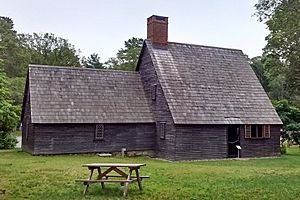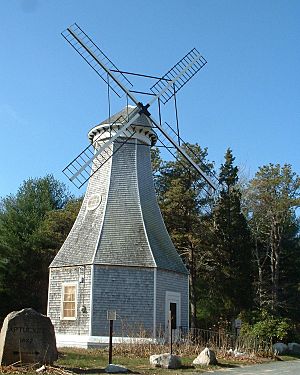Aptucxet Trading Post Museum facts for kids

Replica of the Aptucxet Trading Post
|
|
| Lua error in Module:Location_map at line 420: attempt to index field 'wikibase' (a nil value). | |
| Established | 1930 |
|---|---|
| Location | Bourne, Massachusetts |
| Type | Historic site |
| Owner | Bourne Historical Society |
The Aptucxet Trading Post Museum is a cool outdoor history museum in Bourne, Massachusetts. Its main feature is a copy of the Aptucxet Trading Post. This original trading post was built way back in the 1600s by the Pilgrims from Plymouth Colony. They used it to trade with the Wampanoag people and the Dutch settlers.
The museum also has a copy of a 1800s saltworks, which made salt from the ocean. You can also see the old Gray Gables Railroad Station and a wooden smock windmill. This historic place was added to the National Register of Historic Places in 2021.
Contents
The Original Aptucxet Trading Post
In 1627, English colonists from Plymouth Colony built a trading post. It was about 20 miles (32 km) south of Plymouth. This spot was called Aptucxet, on the Manamet River. It was their first lasting settlement on Cape Cod. The colonists had visited the area before to trade for corn and beans. The name Aptucxet comes from the Wampanoag language. It means "little trap in the river," possibly for catching fish.
Why Was the Trading Post Built?
The main reason for the post was to trade with the Wampanoag people. The colony needed corn and beans from the Native Americans. Some colonists also hoped to trade furs. They wanted to sell these furs to help pay back money they owed to England. The trading post also became a place for the English to trade with the Dutch. The Dutch colonists lived in New Amsterdam, which is now New York City.
Aptucxet was the first trading post built by the Plymouth colonists. Later, they built others, like one in Windsor Locks, Connecticut in 1633. Another was the Cushnoc Trading Post in Augusta, Maine. Aptucxet was far from Plymouth Colony. Colonists lived there all year round. A big storm in 1635 damaged one of the buildings. The post was no longer used by the 1650s. The land later became part of a farm.
Discovering the Old Trading Post
The first time people dug for old items here was in 1852. John Batchelder and William Russell dug up part of a double cellar. They thought it was from the original Aptucxet Trading Post. Some people today think it might have been a later building. The Bourne Historical Society bought the land in 1922.
A full dig happened between 1926 and 1929. Percival Hall Lombard and Nathan Bourne Hartford led this work. The museum's current replica building was built in 1930. It stands on the original foundations found during these digs.
The Cape Cod Canal Connection
In the early 1900s, the Manamet and Scusset Rivers were made wider. They were connected to create the Cape Cod Canal. This new canal follows a path very similar to what the Pilgrims used. They traveled this way to reach the Aptucxet Trading Post. So, the museum is now right on the banks of the Cape Cod Canal.
The Saltworks Replica
The museum also has a copy of a saltworks. These were used in the 1800s to make sea salt. The saltworks have square wooden tubs. Seawater was poured into these tubs and left to dry up. Each tub has a sliding roof. This roof can be moved to protect the water from dew and rain. The museum's replica was built in 1967. It was rebuilt again in 2000 and 2014.
Gray Gables Railroad Station
The museum is home to the actual station building from the old Gray Gables Railroad Station. This station was built in 1892. It was close to President Grover Cleveland's summer house, called Gray Gables. The station even had a direct telegraph line to Washington, D.C.!
The station closed in the 1940s. The Bourne Historical Society bought it in 1976. It was moved to the Aptucxet Trading Post Museum in 1977. The building was fixed up in 2014.
See also



